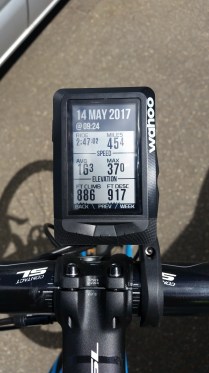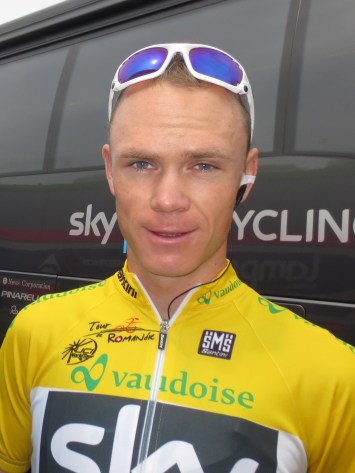Better known for their indoor trainer range US brand Wahoo have taken what some might say is a brave decision to enter the ultra competitive bike GPS market. Competitive is certainly one word to use to describe the GPS sector. I could also describe the near monopoly status of most riders (myself included) go to brand Garmin who have left a string of rivals on the canvas, knocked out by the sheer omnipresence of devices like the 520 and 1000.

Wahoo have launched two devices; the Elemnt that I will review here and the Bolt. The Bolt has a smaller form factor than the Elemnt but also comes with an additional USP in that the device itself and it’s (supplied) bar mount are designed to save time and power over a given distance. This feature is very much in keeping with Wahoo’s brand ethos of harnessing technology to improve results.
Of course PB’s are all relative and as someone who is firmly towards the duffer end of the athletic spectrum i’m not entirely sure a few watts here and there are going to have as much of an impact as a few kilos off the VCSE waistline. Sized about a third as big again as its little brother the Bolt the Elemnt is perhaps the ideal partner for those of us that want the data but also want to enjoy the ride. Priced at £249.99 it’s firmly in Garmin 520 territory and that’s a device that like its predecessors the 500 and 510 feels like the GPS for most riders most of the time. It makes sense to compare the Elemnt with a Garmin device as it’s generally always going to be a Garmin product that you will be bench-marking against; whether that’s an existing device or a potential upgrade.
The Elemnt has one significant advantage over the 520 straight out of the box as it offers mapped navigation. Sure the map itself isn’t super sophisticated but it’s a lot easier to see how to get back onto a downloaded route with the Elemnt if you have taken a wrong turn somewhere. All of that’s kind of secondary really in comparison to where I think the Wahoo really scores; ease of use and set up. Ask anyone who uses a Garmin and most will probably say that they pretty much bypass using Garmin’s proprietorial Connect software and app. Garmin always wanted Connect to be some kind of Strava rival. Ironic really when you consider Strava is to cycling apps what Garmin is to bike GPS. Wahoo do have an app for the Elemnt but unlike Connect it positively reinforces use of Strava.
The Elemnt app is the jump off point for setting up the device and it’s super easy to link to your Strava account. Wahoo also supports an app and software called ‘Ride with GPS’. I hadn’t come across Ride with GPS before and probably wouldn’t have done if I hadn’t been wondering how to get a route on to the Elemnt so I could test its navigation abilities. The good news for those of you reading this review who are similarly in the dark with regard to this interloper is that you don’t need to use it at all. Opening up the Elemnt app I clicked the ‘Routes’ tab and discovered that all of my Strava routes had been synced over already. I created a local loop and within a few seconds of saving it on the laptop it had appeared in the Elemnt app. Loading the route onto the Elemnt couldn’t be easier with a bluetooth connection between your phone and the device and when you’re ready to go you can start the ride from the app or from the device itself.
I had been impressed with how easy it was to set up the Elemnt too. I have been using a demo unit that’s had a few users before me so anyone doing a from the box set up from new will find things simple and quick to do. In comparison to a Garmin set up, the Wahoo is faster and far more intuitive. The Elemnt supports integration for things like Di2 and power and I will admit I haven’t tested these as I wasn’t riding my own bike for this test but if pairing a HRM is anything to go by it should be a doddle. Connecting just involves a few button presses (the three buttons on the base of the unit default to various uses dependent on the display) and then holding the device to the HRM or vice versa. Even my third party Polar strap and Garmin HRM couldn’t faze the Elemnt and another neat feature was that the everything you connect automatically shows up as an additional field on the screen.

The Elemnt has a similar display to an Amazon Kindle and it’s pretty clear even in direct sunlight. OK, so it’s not a colour display but given the additional feature set over the 520 I think it’s a compromise most people could live with. Most of the info you could want on a ride is available via the default screen including speed, distance and calories burned. As I wasn’t connecting power or cadence I didn’t miss the data (although cadence is shown on the ‘front page’ too). Scrolling through the screens brings up additional data fields and then the mapping. When following a route it’s clearly shown on the map and if you’re not looking at the map the lights on the the edge of the screen provide prompts. These LED’s can be programmed to highlight optimum power or to indicate if you’re on course for your time on the bike course for a triathlon. I’m pretty sure I am only scratching the surface of what the Elemnt can do based on this short test. I was pleasantly surprised to see that the Elemnt had determined suggested HR and Power training zones and an estimated FTP figure for me after just two rides.
I guess the $64,000 question is should you choose an Elemnt over the default choice GPS. Based on my experience I would say definitely. The Elemnt is quick and easy to set up and the link between the device and the supporting app is not some kind of gimmick to try and provide a point of difference. There’s no gamble involved in choosing the Elemnt over the competition. Take the time to get to know it and even if you use the bare minimum of connectivity you’ll be getting usable training data from the get go.
Pros – ease of set up, intuitive UI, great integration between the app and device. A genuine alternative to Garmin
Cons – device must be switched on to sync ride data, Bolt definitely got the looks
Further thoughts…
A niggling back injury has kept me off the bike recently but I noticed that my original post had stirred a bit of BTL comment on social media. It’s always interesting to see how people react to what are essentially op ed posts. Even a review is based on my own experience or take on a particular product; I’m not suggesting it’s in any way definitive.
But let’s get back to the Elemnt.
I did get around to pairing it with my powermeter and I can confirm it was just as easy to do that as it was to pair an HRM. The biggest learn for me came from getting to know the Wahoo app better. I initially loved that I didn’t have to go through a series of menus on the device to add a new data field; the Wahoo (as I describe above) does that automatically. What I hadn’t realised was how easy it is to add and remove data fields from the Elemnt screen via the app, including rearranging the order of data fields, customising screens and resizing key read outs like watts.
OK, all of this is possible on a Garmin but it’s way faster to do it via your phone touchscreen.
Another area that stimulated some debate is the Elemnt’s navigation features. I hadn’t gone into much detail on this as my rides had all taken place on local roads. Yeah, I had sent a route to the Elemnt but if I did deviate from it I wasn’t about to get lost. I’m still not able to say whether or not the Elemnt is any better than a Garmin in this respect. If you want to know if the Elemnt can get you back on course after inadvertently straying away from a planned route, you’re not going to find that info here. What I would say is that if you do get ‘lost’ by a few hundred yards from a route plan is; ‘so what?’ Now at this point someone will say; ‘Ah, but what if you get routed on to a motorway?’ My opinion is that if you slavishly follow the arrows on your navigation device a la Chris Froome looking at his stem, you kinda deserve to end up there!
Much has been written and discussed about the Ride With software that Wahoo suggest / recommend. I was put off by that as soon as I saw the subscription model and what felt like a clunky UI from the outset. The Elemnt allows you to input a planned route from Strava quickly and easily via the app. If you’re unfamiliar with the roads you’re going to be riding on Strava can suggest a route that’s popular with other riders. That’s enough navigation for me thanks.
So do I think you should still choose an Elemnt over a Garmin. If you want my opinion, yes. There will always be someone out there for whom a device is better or worse for a very specific reason. I also get, that it’s not always possible to test a product in depth before you buy; I’m lucky to be able to do that. After ‘living’ with the Elemnt for a few months now though I still think it’s worth making the change from the default choice to the new kid on the block.











